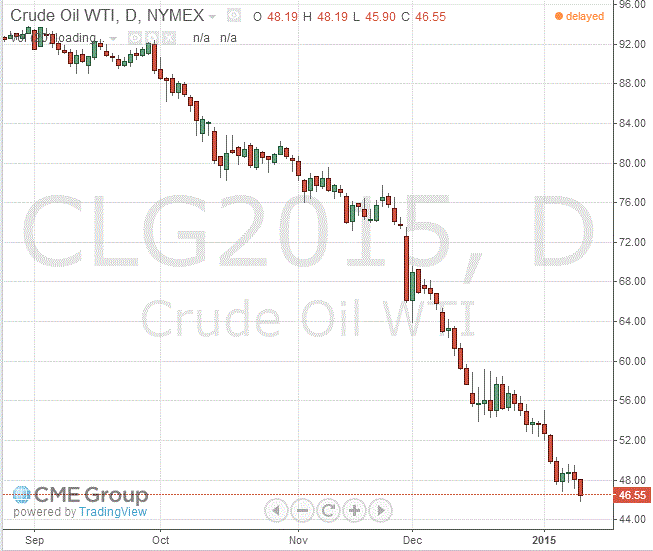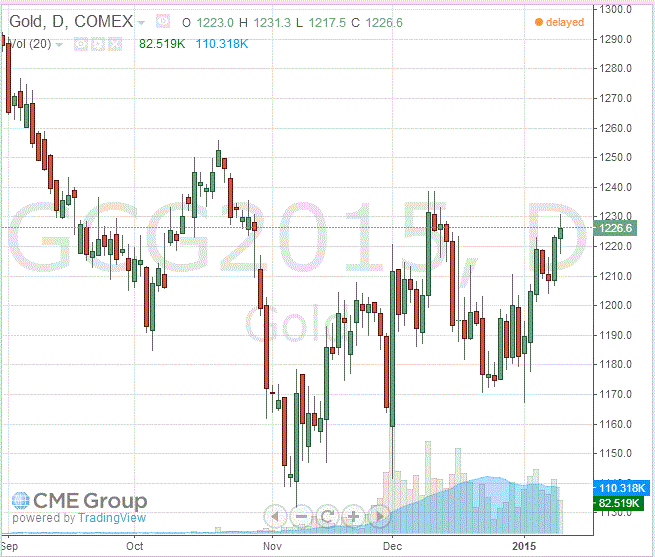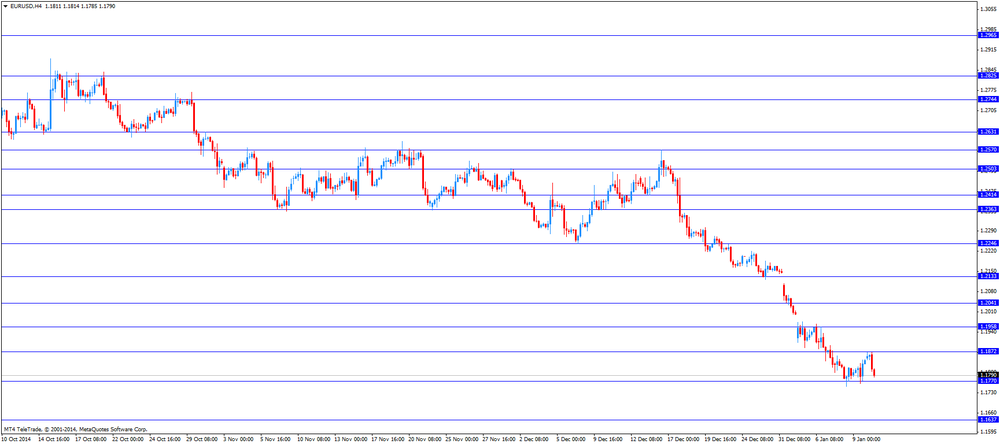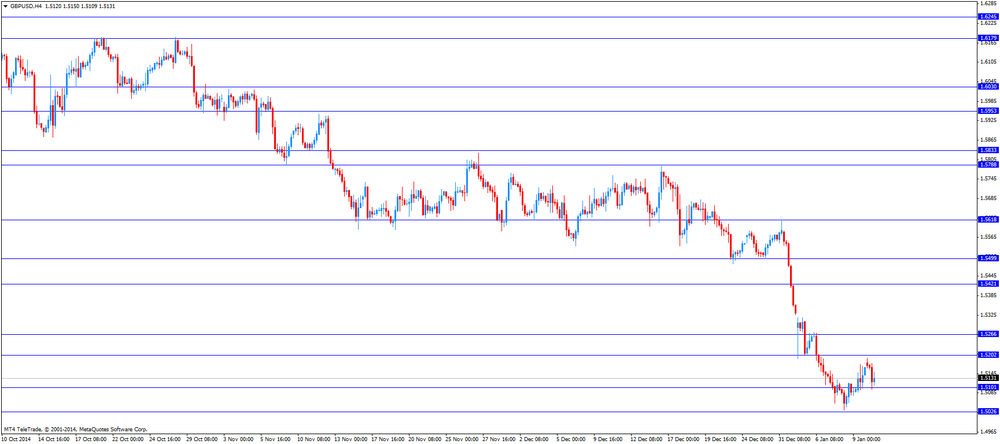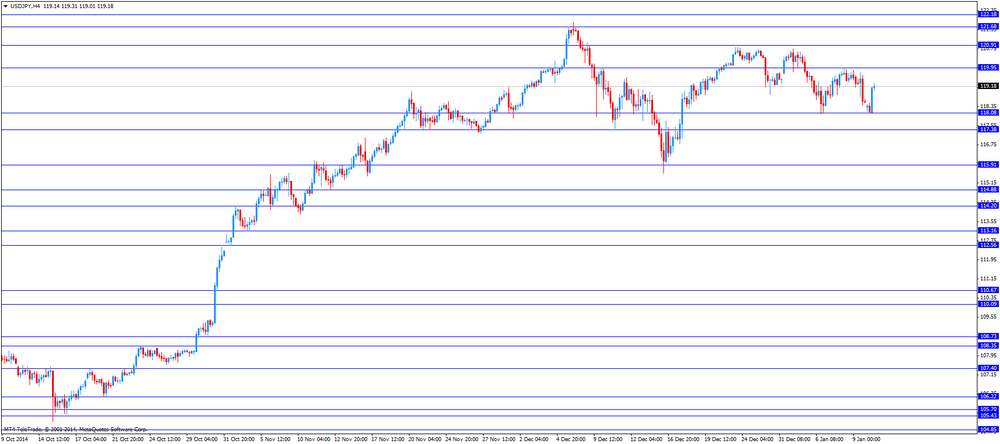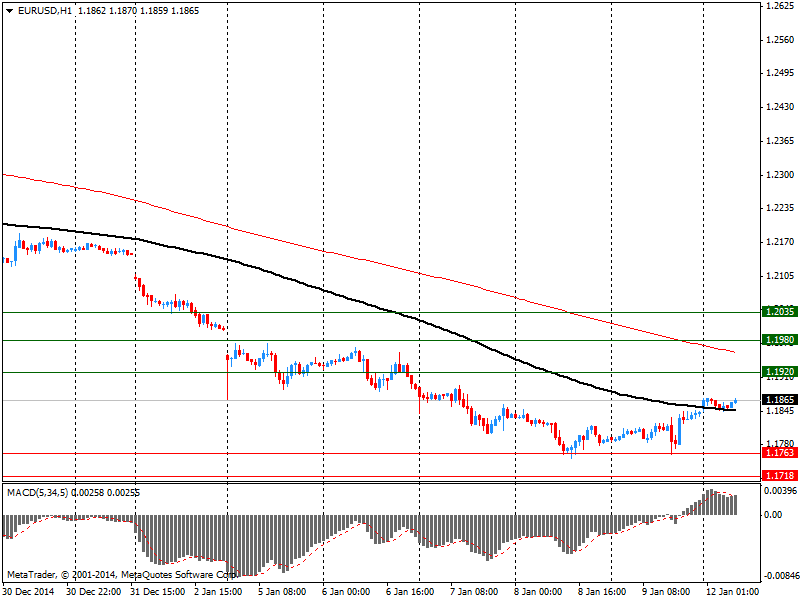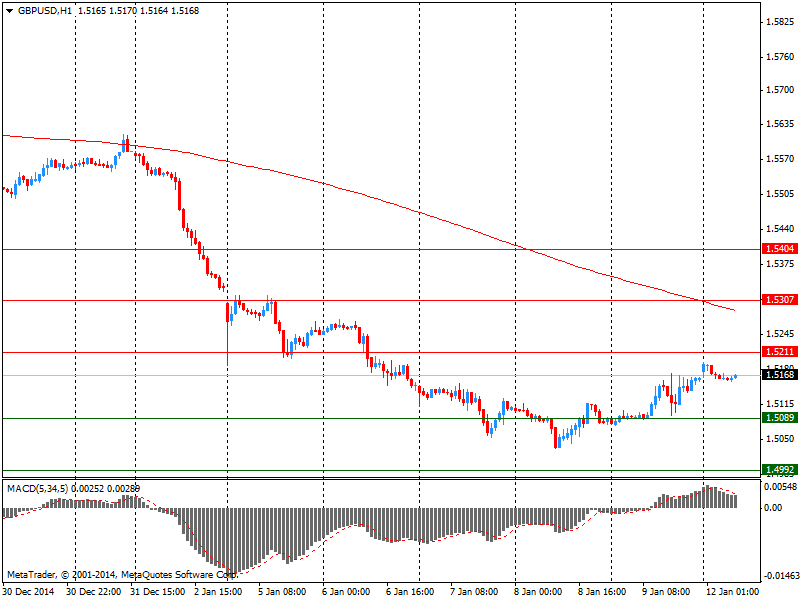Notícias do Mercado
-
23:50
Japan: Current Account (adjusted), bln, November 433.0 (forecast 133.2)
-
23:31
Commodities. Daily history for Jan 12’2015:
(raw materials / closing price /% change)
Light Crude 45.71 -0.78%
Gold 1,233.40 +0.05%
-
23:30
Stocks. Daily history for Jan 12’2015:
(index / closing price / change items /% change)
Hang Seng 24,026.46 +106.51 +0.45%
Shanghai Composite 3,231.06 -54.35 -1.65%
FTSE 100 6,501.42 +0.28 0.00%
CAC 40 4,228.24 +49.17 +1.18%
Xetra DAX 9,781.9 +133.40 +1.38%
S&P 500 2,028.26 -16.55 -0.81%
NASDAQ Composite 4,664.71 -39.36 -0.84%
Dow Jones 17,640.84 -96.53 -0.54%
-
23:27
Currencies. Daily history for Jan 12’2015:
(pare/closed(GMT +2)/change, %)
EUR/USD $1,1833 -0,08%
GBP/USD $1,5171 +0,05%
USD/CHF Chf1,0146 +0,07%
USD/JPY Y118,34 -0,17%
EUR/JPY Y140,03 -0,26%
GBP/JPY Y179,53 -0,13%
AUD/USD $0,8155 -0,58%
NZD/USD $0,7781 -0,75%
USD/CAD C$1,1972 +0,89%
-
23:01
Schedule for today, Tuesday, Jan 13’2015:
(time / country / index / period / previous value / forecast)
00:01 United Kingdom BRC Retail Sales Monitor y/y December +0.9%
02:00 China New Loans December 853 885
02:00 China Trade Balance, bln December 54.50 49.85
05:00 Japan Eco Watchers Survey: Current December 41.5 44.3
05:00 Japan Eco Watchers Survey: Outlook December 44.0
09:30 United Kingdom Retail Price Index, m/m December -0.2% +0.2%
09:30 United Kingdom Retail prices, Y/Y December +2.0% +1.6%
09:30 United Kingdom Producer Price Index - Input (MoM) December -1.0% +0.3%
09:30 United Kingdom Producer Price Index - Input (YoY) December -8.8% -12.2%
09:30 United Kingdom Producer Price Index - Output (MoM) December +0.2% -0.4%
09:30 United Kingdom Producer Price Index - Output (YoY) December -0.1% -0.6%
09:30 United Kingdom HICP, m/m December -0.3% +0.1%
09:30 United Kingdom HICP, Y/Y December +1.0% +0.7%
09:30 United Kingdom HICP ex EFAT, Y/Y December +1.2% +1.4%
15:00 U.S. JOLTs Job Openings November 4834 4848
19:00 U.S. Federal budget December -56.8 24.9
21:30 U.S. API Crude Oil Inventories January -4.0
-
20:00
Dow -99.96 17,637.41 -0.56% Nasdaq -38.93 4,665.14 -0.83% S&P -16.66 2,028.15 -0.81%
-
17:00
European stocks closed: FTSE 100 6,501.42 +0.28 0.00% CAC 40 4,228.24 +49.17 +1.18% DAX 9,781.9 +133.40 +1.38%
-
17:00
European stocks close: stocks closed higher as drug makers shares climbs
Stock indices closed higher as drug makers shares climbs.
There were released no major economic reports in the Eurozone.
Statistical offices in France and Italy and Germany's Ifo Institute released its growth forecast on Monday. The gross domestic product (GDP) is expected to grow 0.3% in first and second quarter of 2015, driven by domestic.
Inflation in the Eurozone is expected to be near zero in the first quarter 2015 and +0.2% in the second 2015.
The Organization for Economic Cooperation and Development (OECD) released its leading indicators on Monday. The composite leading indicator increased to 100.5 in November from 100.4 in October.
The leading indicators signalled stable growth momentum for the United States, Canada and China, while it showed a slowdown in Germany, Italy, Russia and the U.K.
Lower level of momentum is expected in France, Brazil and in the whole Eurozone.
The Slovak news agency TASR quoted the European Central Bank's (ECB) governing council member Jozef Makuch on Monday. Makuch said the ECB is ready to implement quantitative easing if needed.
Indexes on the close:
Name Price Change Change %
FTSE 100 6,501.42 +0.28 0.00%
DAX 9,781.9 +133.40 +1.38%
CAC 40 4,228.24 +49.17 +1.18%
-
16:44
Bank of Canada's Business Outlook Survey: business sentiment in Canada remains positive
The Bank of Canada released its Business Outlook Survey on Monday. The survey showed that business sentiment in Canada has remained positive, but falling oil prices have a negative impact on the outlook for companies tied to the energy sector. Sales are expected to grow at a slightly faster pace in 2015, the report said.
According to the report, "firms anticipating a positive impact from the U.S. economic recovery are more optimistic than others".
-
16:40
Oil: a review of the market situation
The price of oil continued to decline today, reaching with nearly six-year low, which was associated with the decision of Goldman Sachs and Societe Generale cut its short-term outlook for oil prices.
As it became known, experts Goldman Sachs downgraded the outlook for the cost of WTI crude oil for the next three months, up to $ 41 per barrel to $ 70 per barrel, the forecast for Brent - up to $ 42 from $ 80 per barrel.
Meanwhile, Societe Generale analysts downgraded the outlook for the entire cost of Brent in 2015 from $ 70 to $ 55 per barrel, WTI - from $ 65 to $ 51 per barrel.
"The deterioration forecasts two largest banks strengthened those fears that have been dipped quotes on their current level, - said the expert Jean MakDzhillian Tradition Energy. - The market still struggles to find the bottom, but the bottom where it remains a mystery to all."
Earlier, analysts Bank of America Merrill Lynch released a forecast, which states that in the short term, Brent will fall in price to $ 40 per barrel. According to experts, the cost of the US WTI crude oil falls to $ 35 per barrel. All this will lead to what will have to cut production or Saudi Arabia or countries outside of OPEC, said in a note ..
Meanwhile, Venezuelan President Nicolas Maduro said that OPEC should find a consensus with other oil producers and to develop a common strategy to support the oil market and stabilize the situation in the global economy. During his visit to Iran, he said that in order to achieve economic equilibrium required return of oil prices to the level of $ 100 per barrel
However, a member of the royal family of Saudi Arabia Al-Waleed bin Talal said that oil prices are unlikely to rise again to $ 100 per barrel. "If the offer will remain at the same level and consumption will be low, we should expect further fall in oil prices. But if the market will lose part of the proposal, while consumption will grow somewhat, prices can go up. But I'm sure that we'll never see oil at $ 100 I said a year ago that the price of oil over $ 100 artificial "- he said in an interview.
The cost of the February futures on US light crude oil WTI (Light Sweet Crude Oil) dropped to 46.55 dollars per barrel on the New York Mercantile Exchange.
February futures price for North Sea Brent crude oil mix fell $ 1.55 to $ 47.88 a barrel on the London Stock Exchange ICE Futures Europe. Earlier, futures touched $ 49.66, the lowest level since April 29, 2009.
-
16:32
Foreign exchange market. American session: the Canadian dollar traded lower against the U.S. dollar after the release of the Bank of Canada's Business Outlook Survey
The U.S. dollar traded mixed against the most major currencies. The greenback recovered Friday's losses. The U.S. currency declined on Friday as investors speculated that the Fed might delay its first interest rate hike due to the weak wage growth. Average hourly earnings decreased 0.2% in December.
The U.S. Labor Department released the labour market data on Friday. The U.S. economy added 252,000 jobs in December. The U.S. unemployment rate fell to 5.6% in December from 5.8% in November, exceeding expectations for a decline to 5.7%.
The euro traded higher against the U.S. dollar in the absence of any major economic reports from the Eurozone. Political uncertainty in Greece and inflation data from the Eurozone still weighed on the euro.
Investors speculate that the European Central Bank could decide on its policy meeting on January 22 to purchase government bonds.
The British pound traded mixed against the U.S. dollar in the absence of any major economic reports from the U.K.
The Canadian dollar traded lower against the U.S. dollar after the release of the Bank of Canada's Business Outlook Survey. The survey showed that business sentiment in Canada has remained positive, but falling oil prices have a negative impact on the outlook for companies tied to the energy sector.
The New Zealand dollar traded lower against the U.S. dollar in the absence of any major economic reports from New Zealand.
The Australian dollar traded lower against the U.S. dollar. In the overnight trading session, the Aussie traded higher against the greenback after the mixed economic data from Australia. Job advertisements in Australia increased 1.8% in December, after a 0.7% rise in November. That was the seventh consecutive increase.
Home loans in Australia fell 0.7% in November, missing expectations for a 1.8% rise, after a 0.2% increase in October. October's figure was revised down from a 0.3% gain. That are signs of a weakening in the housing sector.
The Japanese yen traded higher against the U.S. dollar. In the overnight trading session, the yen traded mixed against the greenback. Markets in Japan were closed for a public holiday.
Japan's government released its growth forecasts for the next fiscal year on Monday. The economy is expected to expand 1.5% in the fiscal year through March 2016, up from an earlier forecast of 1.4%. But the government lowered its growth forecast for the current fiscal year to a -0.5%, down from the previous forecast of 1.2%.
-
16:20
Gold: A review of the market situation
Gold prices recovered, while closer to the month high, due to the fall in US stock indices, as well as a slight weakening of the US dollar.
Falling bond yields caused the dollar index to retreat from the daily high. Yields on 10-year US securities decreased by 2.9 bp to 1.94%, and 2-year bonds - by 1.6 bp up to 0.561%. Meanwhile, DJIA and S & P are falling on the background of the collapse of the shares of energy companies. Precious metal may continue to grow, if the fall in stock markets will trigger risk aversion.
Market participants also monitored on the dynamics of the oil market. "Low oil prices tend to adversely affect the gold, but prolonged drop in prices raises concerns that further losses will have a detrimental effect on the financial markets and oil-exporting countries. This creates demand for gold as a safe asset," - said analyst HSBC James Steele.
Gold futures in recent days have been supported, as political uncertainty in Greece and concerns about the impact of falling oil prices on the global economy led investors to buy the precious metal. Some investors buy gold, believing that in turbulent times, it is better to retain its value than other assets.
Stocks of the largest gold ETF-secured fund SPDR Gold Trust on Friday rose 0.42 percent to 707.82 tons.
Increase in the price of gold also helps to increased demand in the physical markets, particularly in China on the eve of the New Year according to the lunar calendar, which is celebrated in February. Margins on the Shanghai Gold Exchange held at the level of last week's $ 05.04 per ounce.
The cost of the February gold futures on the COMEX today rose to 1226.60 dollars per ounce.
-
16:15
European Central Bank’s (ECB) governing council member Jozef Makuch: the central bank is ready to implement quantitative easing if needed
The Slovak news agency TASR quoted the European Central Bank's (ECB) governing council member Jozef Makuch on Monday. Makuch said the ECB is ready to implement quantitative easing if needed.
He also said that he did not expect inflation in the Eurozone to reach the ECB's 2% earlier than at the end of 2016.
-
15:59
Eurozone’s economy is expected to grow 0.3% in first and second quarter of 2015
Statistical offices in France and Italy and Germany's Ifo Institute released its growth forecast on Monday. The gross domestic product (GDP) is expected to grow 0.3% in first and second quarter of 2015, driven by domestic.
Inflation in the Eurozone is expected to be near zero in the first quarter 2015 and +0.2% in the second 2015.
The report said that upside risks are a further depreciation of the euro and a greater fall in oil prices. Downside risks are the outcome of the parliamentary elections in Greece, according to the report.
-
15:37
The European Central Bank purchased 48 million euros of asset-backed securities and 1.659 billion euros of covered-bond purchases last week.
-
15:15
Japan’s government cut its economic growth forecast for the next fiscal year
Japan's government released its growth forecasts for the next fiscal year on Monday. The economy is expected to expand 1.5% in the fiscal year through March 2016, up from an earlier forecast of 1.4%. But the government lowered its growth forecast for the current fiscal year to a -0.5%, down from the previous forecast of 1.2%.
-
15:05
OECD’s leading composite leading indicator increased in November
The Organization for Economic Cooperation and Development (OECD) released its leading indicators on Monday. The composite leading indicator increased to 100.5 in November from 100.4 in October.
The leading indicators signalled stable growth momentum for the United States, Canada and China, while it showed a slowdown in Germany, Italy, Russia and the U.K.
Lower level of momentum is expected in France, Brazil and in the whole Eurozone.
The economic growth of the U.S. and Canada will remain at current level.
The leading indicators for China, India and Japan indicate positive and firming changes.
The OECD's leading indicators provide early signals of turning points between the expansion and slowdown of economic activity.
-
14:34
U.S Stocks open: Dow 17,783.03 +45.66 +0.26%, Nasdaq 4,714.40 +10.33 +0.22%, S&P 2,049.06 +4.25 +0.21%
-
14:29
Before the bell: S&P futures +0.14%, Nasdaq futures +0.19%
U.S. stock-index futures rose as corporate deals overshadowed a further drop in crude and investors awaited earnings reports.
Global markets:
Hang Seng 24,026.46 +106.51 +0.45%
Shanghai Composite 3,231.06 -54.35 -1.65%
FTSE 6,498.28 -2.86 -0.04%
CAC 4,213.96 +34.89 +0.83%
DAX 9,733.86 +85.36 +0.88%
Crude oil $46.55 (-3.74%)
Gold $1222.80 (+0.55%)
-
14:00
Upgrades and downgrades before the market open
Upgrades:
Downgrades:
Goldman Sachs (GS) downgraded to Mkt Perform from Mkt Outperform at JMP Securities
Google (GOOG) downgraded to Neutral from Overweight at Atlantic Equities
Other:
-
13:52
Goldman Sachs cut its oil price forecasts
The U.S. investment bank Goldman Sachs cut its oil price forecasts on Monday. The bank expects Brent price of $50.40 a barrel in 2015, down from an earlier forecast of $83.75, and WTI price of $47.15 per barrel in 2015, down from an earlier forecast of $73.75.
Goldman Sachs lowered its 2016 Brent price forecast to $70, down from $90, and WTI price to $65, down from $80.
On a 3-, 6- and 12-month basis, the bank sees Brent to be at $42, $43 and $70 respectively, down from $80, $85 and $90.
The WTI price is expected to be at $41, $39 and $65 on a 3-, 6- and 12-month basis, down from $70, $75 and $80 a barrel.
Oil prices have dropped more than 50 percent since mid-2014, reaching their lowest levels since 2009.
-
13:50
Option expiries for today's 10:00 ET NY cut
EUR/USD: $1.1810(E203mn), $1.1850(E247mn), $1.1875(E241mn), $1.1900(E908mn)
USD/JPY: Y118.00($383mn), Y118.35($200mn), Y118.40($325mn), Y118.50($250mn), Y118.75($220mn)Y119.65($570mn), Y120.00($2.65bn)
EUR/CHF: Chf1.1950(E720mn), Chf1.2010(E234mn)
AUD/USD: $0.8250(A$352mn)
AUD/JPY: Y95.75(A$332mn)
AUD/NZD: NZ$1.0550(A$391mn)
USD/CAD: C$1.1750($213mn)
EUR/CAD: C$1.4000(E230mn)
-
13:03
Foreign exchange market. European session: the U.S. dollar traded higher against the most major currencies, recovering its Friday’s losses
Economic calendar (GMT0):
(Time/ Region/ Event/ Period/ Previous/ Forecast/ Actual)
00:00 Japan Bank holiday
00:30 Australia ANZ Job Advertisements (MoM) December +0.7% +1.8%
00:30 Australia Home Loans November +0.2% Revised From +0.3% +1.8% -0.7%
The U.S. dollar traded higher against the most major currencies, recovering its Friday's losses. The greenback declined on Friday as investors speculated that the Fed might delay its first interest rate hike due to the weak wage growth. Average hourly earnings decreased 0.2% in December.
The U.S. Labor Department released the labour market data on Friday. The U.S. economy added 252,000 jobs in December. The U.S. unemployment rate fell to 5.6% in December from 5.8% in November, exceeding expectations for a decline to 5.7%.
The euro dropped against the U.S. dollar in the absence of any major economic reports from the Eurozone. Political uncertainty in Greece and inflation data from the Eurozone still weighed on the euro.
Investors speculate that the European Central Bank could decide on its policy meeting on January 22 to purchase government bonds.
The British pound traded lower against the U.S. dollar in the absence of any major economic reports from the U.K.
The Canadian dollar traded lower against the U.S. dollar ahead of the Bank of Canada's Business Outlook Survey.
EUR/USD: the currency pair fell to $1.1785
GBP/USD: the currency pair decreased to $1.5097
USD/JPY: the currency pair rose to Y119.31
The most important news that are expected (GMT0):
15:30 Canada Bank of Canada Business Outlook Survey Quarter IV
17:40 U.S. FOMC Member Dennis Lockhart Speaks
23:50 Japan Current Account (adjusted), bln November 883.4 133.2
-
12:50
Orders
EUR/USD
Offers $1.1975-85, $1.1950/60, $1.1930, $1.1890-900
Bids $1.1700
GBP/USD
Offers $1.5250, $1.5195/205
Bids $1.5055/50
AUD/USD
Offers $0.8300, $0.8200
Bids $0.8150, $0.8100, $0.8060/50
EUR/JPY
Offers Y141.95/00, Y141.50, Y141.00
Bids Y140.00, Y139.50, Y139.00
USD/JPY
Offers Y120.00, Y119.50
Bids Y118.85/80, Y118.50, Y118.00
EUR/GBP
Offers stg0.7950/55, stg0.7900, stg0.7880/85
Bids stg0.7720, stg0.7700
-
12:45
Home loans in Australia unexpectedly dropped 0.7% in November
The Australian Bureau of Statistics released its home loans data on Monday. Home loans in Australia fell 0.7% in November, missing expectations for a 1.8% rise, after a 0.2% increase in October. October's figure was revised down from a 0.3% gain. That are signs of a weakening in the housing sector.
Growth in recent months was driven by cheap credit as interest rate in Australia has remained at a record low of 2.5% since August 2013. The Reserve Bank of Australia is concerned over the sharp increase in house prices, and it is eager to prevent Australian housing market from overheating.
-
12:27
Australian ANZ job advertisements rose 1.8% in December, the seventh consecutive increase
The Australia and New Zealand Banking Group Limited (ANZ) released its job advertisements figures on Monday. Job advertisements in Australia increased 1.8% in December, after a 0.7% rise in November. That was the seventh consecutive increase.
The ANZ chief economist Warren Hogan noted: "The good news is that the economy continues to produce new employment opportunities. The bad news is that this has not been quite enough to counteract the flow of new workers into the economy plus the on-going loss of jobs in certain sectors".
-
12:00
European stock markets mid-session: European indices rebound on optimism of QE starting rather sooner than later and falling oil prices
European indices added in today's trading supported by airlines and the automotive industry fuelled by oil trading at 5 ½-year lows. Brent dropped below USD49, its lowest since April 2009. Investors are looking forward to the European Central Bank policy meeting taking place on January 22nd and the Greek elections on January 25th that will keep markets volatile in the near future. As the Eurozone faces the risk of deflation the possibility of the ECB to buy government bonds is growing. Eurozone's consumer prices dropped an annual 0.2% in December declining for the first time in five years.
In today's session the FTSE 100 index added +0.34% quoted at 6,523.00 losing some of its early gains. France's CAC 40 gained +1.50% trading at 4,241.93. Germany's DAX 30 is currently trading +1.48% at 9,791.00 points further extending the good start.
-
11:20
Oil: Prices extend falls as Goldman Sachs cuts forecast for 2015
Brent crude and West Texas Intermediate slumped on Monday trading at 5-1/2-year lows, the lowest since April 2009 and were negative for the last straight seven weeks. Brent Crude lost -2.71%, currently trading at USD48.75.27 a barrel. West Texas Intermediate declined by -2.30% currently quoted at USD47.25 as Goldman Sachs cut its 2015 price forecast foreseeing rising global supplies. Goldman Sachs does not see Saudi Arabia or any other major OPEC members to cut output rates in 2015 revising previous forecasts that the OPEC might do so. Societe Generale also cut its oil price forecast for 2015 citing a build up in oil storage and inventories in the first half of this year. Fires in refineries in Ohio and Pennsylvania over the weekend were further weighed on demand
The global glut continues in 2015 and a low global demand weighs amid record output from U.S. shale drillers. Both major brands lost more than 50% of their value since mid-2014 but the OPEC, responsible for 40% of worldwide oil-production, decided to leave output-rates unchanged around 30 million barrels a day.
-
11:00
Gold intraday at four-week high
Gold prices declined slightly in today's session with the precious metal currently quoted at USD1,221.90, -0,06% a troy ounce. Intraday gold climbed to a four-week high at USD1,230.90 as the rout in oil-prices continued and market participants expect the Federal Reserve to keep benchmark interest rates unchanged for a longer-than-expected period after mixed U.S. job data on Friday. Data showed that the average hourly earnings fell in December by the most since records began in 2006. On the other hand the Labor Department reported 252,000 newly created jobs beating forecasts of 240,000. Gold was further supported by the upcoming Greek elections on January 25th. A win of the anti-austerity party Syriza could result in an exit from the currency bloc.
GOLD currently trading at USD1,221.90
-
10:20
Option expiries for today's 10:00 ET NY cut
EUR/USD: $1.1810(E203mn), $1.1850(E247mn), $1.1875(E241mn), $1.1900(E908mn)
USD/JPY: Y118.00($383mn), Y118.35($200mn), Y118.40($325mn), Y118.50($250mn), Y118.75($220mn)Y119.65($570mn), Y120.00($2.65bn)
EUR/CHF: Chf1.1950(E720mn), Chf1.2010(E234mn)
AUD/USD: $0.8250(A$352mn)
AUD/JPY: Y95.75(A$332mn)
AUD/NZD: NZ$1.0550(A$391mn)
USD/CAD: C$1.1750($213mn)
EUR/CAD: C$1.4000(E230mn)
-
09:20
Press Review: Oil prices extend falls; Goldman Sachs slashes forecasts
REUTERS
Oil prices extend falls; Goldman Sachs slashes forecasts
(Reuters) - Global oil prices fell by more than $1 a barrel on Monday as Goldman Sachs lowered its short-term forecasts, while refineries in Ohio and Pennsylvania were hit by fires over the weekend, curtailing demand for crude in the United States.
Both Brent and U.S. crude are at their lowest since April 2009 and have fallen for seven straight weeks.
Analysts at Goldman Sachs cut their average forecast for Brent in 2015 to $50.40 a barrel from $83.75. They lowered their forecast for U.S. crude to $47.15 a barrel from $73.75, saying it would need to stay near $40 for most of the first half of 2015 before it would hold up shale oil investments.
Source: http://www.reuters.com/article/2015/01/12/us-markets-oil-idUSKBN0KL03Y20150112
BLOOMBERG
ECB Weighs Bond Purchases Up to 500 Billion Euros to Juice Economy
European Central Bank staff presented policy makers with models for buying as much as 500 billion euros ($591 billion) of investment-grade assets, according to a person who attended a meeting of the Governing Council.
Various quantitative-easing options focused on government bonds were shown to governors on Jan. 7 in Frankfurt, including buying only AAA-rated debt or bonds rated at least BBB minus, the euro-area central bank official said. Governors took no decision on the design or implementation of any package after the presentation, according to the person and another official who attended the meeting. The people asked not to be identified because the talks were private.
BLOOMBERG
Japan Plans Record Budget to Help Economy Hit by Recession
Japan plans a record budget for next fiscal year to support an economy that fell into recession after Prime Minister Shinzo Abe's government increased the sales tax.
Government ministers and the ruling coalition parties approved the 96.34 trillion yen ($814 billion) budget proposal for the 12 months starting April 1 at a meeting in Tokyo today, Finance Minister Taro Aso told reporters.
Japan, fighting to rein in the world's heaviest debt burden, will see tax revenue rise to the highest level in 24 years while new bond issuance declines to the lowest since 2008. Abe's already boosted public works spending and support for small businesses through a supplementary budget for the current year.
-
09:00
European Stocks. First hour: Indices rebound from last Friday’s losses on QE hopes
European indices edge higher in early trading amid speculations on full-scale quantitative easing being decided at the next ECB-meeting taking place on January 22nd. As the Eurozone faces the risk of deflation the possibility of the ECB to buy government bonds is growing. Eurozone's consumer prices dropped an annual 0.2% in December declining for the first time in five years.
Today markets were supported by solid gains in the health-care and financial sector. Energy stocks were under pressure again as the slump in oil prices continued. Markets look ahead to FOMC Member Dennis Lockhart's speech scheduled for 17:40 GMT today.
After a mixed set on U.S. job data U.S. indices point to a higher open.
The FTSE 100 index is currently trading +0.61% quoted at 6,540.58 points, Germany's DAX 30 added +1.14% trading at 9,758.62. France's CAC 40 rose by +1.20%, currently trading at 4,229.04 points.
-
08:00
Global Stocks: U.S. indices weighed down by job data and falling oil
U.S. markets closed lower on Friday after a mixed set of U.S. job data with the unemployment rate declining to 5.6% in December, and hourly earnings decreasing to $24.57. Falling oil prices also weighed on the indices. The DOW JONES index lost -0.95%, 170 points, closing at 17,737.37. The S&P 500 declined by -0.84% with a final quote of 2,044.81 ending a two-day rally.
Hong Kong's Hang Seng added +0.46% to 24,029.33 points. China's Shanghai Composite closed at 3,231.06 points, a loss of -1.65% as investors sell shares to fund upcoming new listings and take profit after the recent rally.
Japan's Nikkei is closed today due to a bank holiday in Japan. On Friday the index added +0.18% closing at 17,197.73 points rising for a third day.
-
07:30
Foreign exchange market. Asian session: U.S. dollar trading flat to negative against its major peers
(Time/ Region/ Event/ Period/ Previous/ Forecast/ Actual
00:00 Japan Bank holiday
00:30 Australia ANZ Job Advertisements (MoM) December +0.7% +1.8%
00:30 Australia Home Loans +0.2% +1.8% -0.7%
The U.S. dollar paused its rally against most major peers in Asian trade after Friday's mixed data on U.S. job reports showed showing incomes declined in December casting doubts on the FED's plans to raise interest rates rather sooner than later. Nevertheless the number of people employed rose more-than-expected to 252,000. The minutes of the FED's last policy meeting released last week showed that the FED is unlikely to raise the benchmark rates for "at least the next couple of meetings".
The Australian dollar traded higher for a third consecutive day after reaching multi-year lows on January 7th fuelled by solid local amid a broadly weakening U.S. dollar. ANZ job Advertisements rose by +1.8% in December, compared to a rise of +0.7% in November - growing at the fastest pace in 2 ½-years. Home Loans declined by -0.7%, not meeting forecasts of a growth at +1.8%. Revised last month's data had a reading of +0.2%.
New Zealand's dollar traded lower after new monthly highs against the greenback retreating from a four-day rally.
The Japanese yen traded stronger during the Asian against the greenback being currently quoted around USD118.29 rising close to its strongest level since December 17th. Japanese markets are closed today for a holiday.
EUR/USD: the euro gained slightly against the greenback
USD/JPY: the U.S. dollar traded slightly weaker against the yen
GPB/USD: The British pound gained against the U.S. dollar
The most important news that are expected (GMT0):
(time / country / index / period / previous value / forecast)
15:30 Canada Bank of Canada Business Outlook Survey Quarter IV
17:40 U.S. FOMC Member Dennis Lockhart Speaks
23:50 Japan Current Account (adjusted), bln November 883.4 133.2
-
06:19
Options levels on monday, January 12, 2015:
EUR / USD
Resistance levels (open interest**, contracts)
$1.2035 (1582)
$1.1980 (745)
$1.1920 (451)
Price at time of writing this review: $ 1.1865
Support levels (open interest**, contracts):
$1.1763 (2114)
$1.1718 (1510)
$1.1661 (1822)
Comments:
- Overall open interest on the CALL options with the expiration date February, 6 is 44846 contracts, with the maximum number of contracts with strike price $1,2100 (4255);
- Overall open interest on the PUT options with the expiration date February, 6 is 50720 contracts, with the maximum number of contracts with strike price $1,1700 (5673);
- The ratio of PUT/CALL was 1.13 versus 0.80 from the previous trading day according to data from January, 9
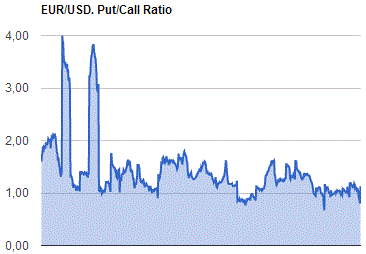
GBP/USD
Resistance levels (open interest**, contracts)
$1.5404 (332)
$1.5307 (313)
$1.5211 (252)
Price at time of writing this review: $1.5168
Support levels (open interest**, contracts):
$1.5089 (1061)
$1.4992 (684)
$1.4895 (954)
Comments:
- Overall open interest on the CALL options with the expiration date February, 6 is 12603 contracts, with the maximum number of contracts with strike price $1,5800 (1108);
- Overall open interest on the PUT options with the expiration date February, 6 is 14206 contracts, with the maximum number of contracts with strike price $1,4800 (1244);
- The ratio of PUT/CALL was 1.13 versus 0.77 from the previous trading day according to data from January, 9

* - The Chicago Mercantile Exchange bulletin (CME) is used for the calculation.
** - Open interest takes into account the total number of option contracts that are open at the moment.
-
02:02
Hang Seng 23,963.83 +43.88 +0.18%, S&P/ASX 200 5,437 -28.57 -0.52%, Shanghai Composite 3,258.21 -27.20 -0.83%
-
00:31
Australia: ANZ Job Advertisements (MoM), December +1.8%
-
00:30
Australia: Home Loans , November -0.7% (forecast +1.8%)
-
